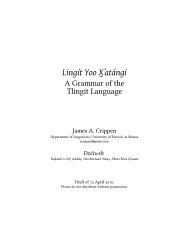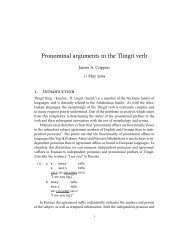A comparison of morphosyntactic features between Marquesan ...
A comparison of morphosyntactic features between Marquesan ...
A comparison of morphosyntactic features between Marquesan ...
Create successful ePaper yourself
Turn your PDF publications into a flip-book with our unique Google optimized e-Paper software.
. ‘ua he‘e te mau vehine<br />
PERF go DEF PC woman<br />
“the (small) group <strong>of</strong> women went” (id.)<br />
c. ‘ua he‘e te tau vehine<br />
PERF go DEF PL woman<br />
“the group <strong>of</strong> women went” (id.)<br />
MQA<br />
MQA<br />
Notably, Mutu & Teìkitutoua describe mou has having a specific dual number,<br />
but mau and tau lack specific number. Consequently, they cannot be used with<br />
postnominal numbers, thus *‘ua he‘e te mau vehine tokoto‘u (tokoto‘u = “three”).<br />
3.2. HAWAIIAN<br />
Elbert & Pukui (1979:162) describe a few “special plurals” for HAW: mau, po‘e, kau,<br />
wahi, nāhi, and ona. Mau is certainly the most common, and functions as the plural<br />
marker in possessive phrases where determiners (ka~ke and nā) are disallowed as<br />
in example 7.<br />
(7) (*nā) ka‘u mau puke<br />
(DET.PL) my PL book<br />
“my books” (Elbert & Pukui 1986:241)<br />
HAW<br />
HAW kau is also apparently cognate with MQA tau, and serves as a plural particle,<br />
e.g. example 8. It is very rare and found mostly in the compounds kauhale<br />
“group <strong>of</strong> houses comprising a home”, kaukolu “group <strong>of</strong> three”, kauwahi “some, a<br />
little”. e meaning <strong>of</strong> each <strong>of</strong> these compounds is somewhat paucal, since kauhale<br />
indicates a limited number <strong>of</strong> buildings which comprise the traditional Hawaiian<br />
home, kaukolu is naturally limted to three, and kauwahi includes the more common<br />
paucal wahi (see below).<br />
(8) a. lawea mai i kau pā ipu a kākou<br />
bring.IMP hither DO PL dish gourd POSS 1INC.PL<br />
“bring our dishes here” (Elbert & Pukui 1986:303, pā ipu)<br />
b. ua ‘ike anei ‘oe i kau pua‘a a mākou<br />
PERF see YN 2SG.S DO PL pig POSS 1EXC.PL<br />
“have you seen our pigs” (id.:134, kau, sense 9)<br />
HAW<br />
HAW<br />
6





